Colorful nylon tents ring Downtown Los Angeles like a beaded necklace, evidence of a homeless population that has surged over 75 percent in just six years, to 58,000, making it the second largest in the United States. The product of a housing shortage, a development boom, and the misallocation of social and mental health services, L.A.’s tent communities are a constant reminder of the collective failure to ensure safe housing alternatives for the most vulnerable. The latest solo show by artist Shinique Smith, “Refuge,” is located near DTLA at the California African American Museum (CAAM). It functions as a powerful reflection on shelter and sanctuary, taking the global epidemic of homelessness as its inescapable reference.
In the last decade, Smith has become well-known for her signature use of used clothing, discarded objects, and personal mementos, through shows at the Museum of Fine Arts, Boston, the Frist in Nashville, and elsewhere. “Refuge” puts these materials in juxtaposition with various sculptural symbols of home. In doing so, she suggests how our possessions, including the things we discard, are a reflection of ourselves, and more importantly, how the people we discard reveal who we are, collectively.
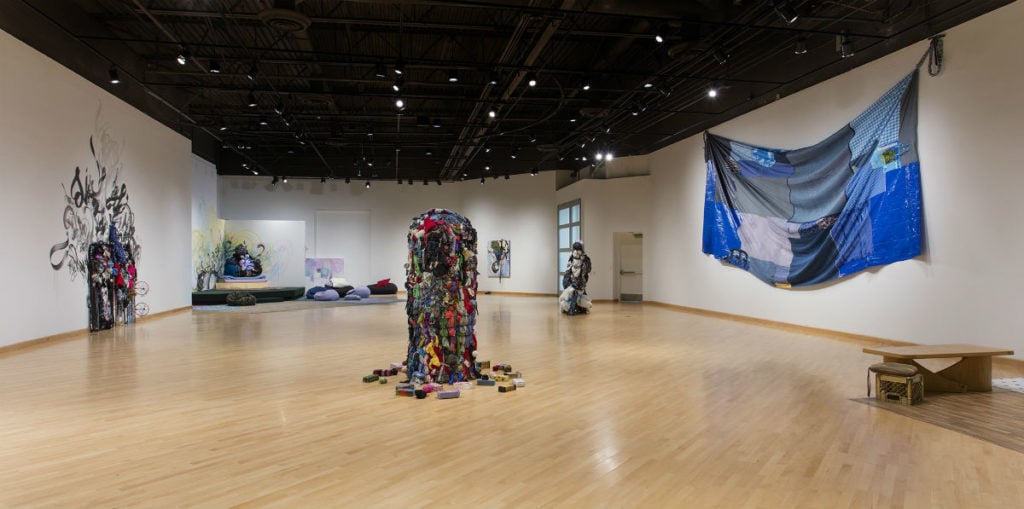
“Shinique Smith: Refuge” at the California African American Museum. Photos by Brian Forrest and courtesy the artist and David Castillo Gallery.
“Refuge” features works that fuse Smith’s abstract paintings with mixed-media collage in murals, assemblage, sculpture, and immersive environments, all fluidly interacting with one another. While the paintings and sculptural works reflect two distinct artistic threads, for Smith, they represent two sides of the same coin. Her paintings evoke a kinetic, explosive style that evolved from her early years as a graffiti writer; her fabric bundles reflect a more contemplative process, one that Smith describes as “ritualistic.”
In one corner of CAAM’s exhibition space, a mural featuring calligraphic strokes of pastel pink, yellow, and blue hues stretches across two walls. Its softness is interrupted by a strong black abstract script that flows into a series of tied fabric bales made from clothing and pillows in shades of indigo, grey, purple, and black. The bundles form a large figure resembling a large Buddha that rests upon three foam beds and a colorful woven rug.
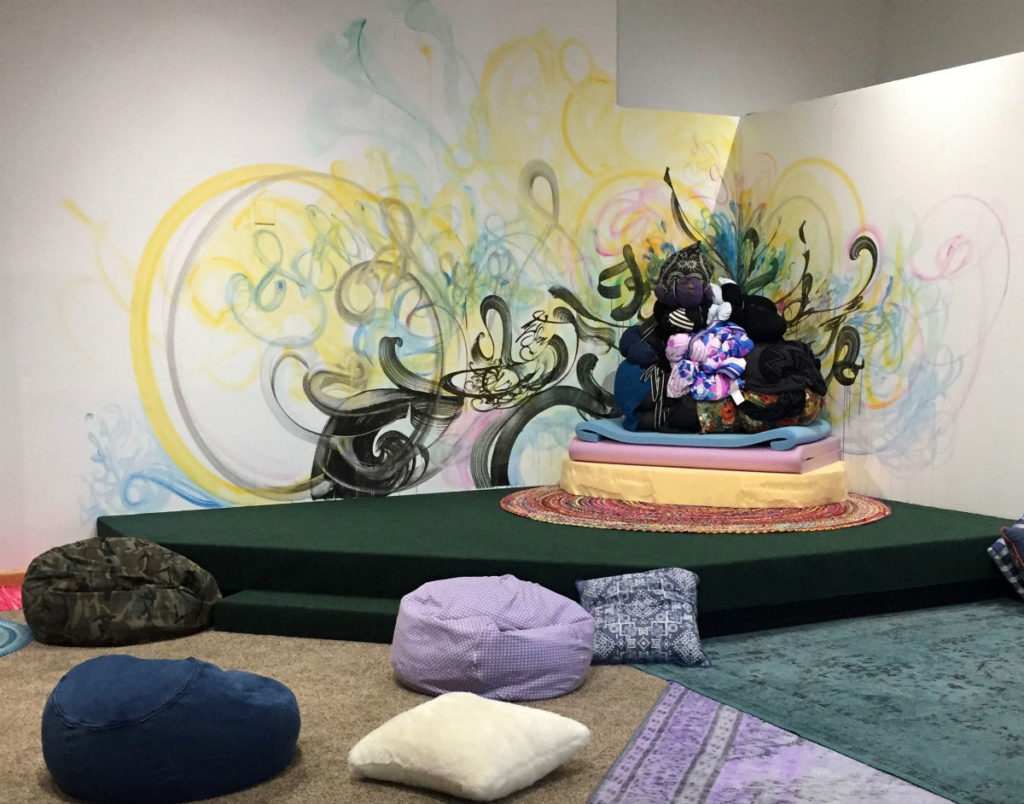
Shinique Smith, Mitumba Deity II (2018) in “Shinique Smith: Refuge” at the California African American Museum. Photo courtesy Colony Little.
The title of this piece, Mitumba Deity, uses the Swahili word for bundle in reference to the similarly named global second-hand clothing trade that’s prevalent in East Africa. With exports of roughly $550 billion dollars, the U.S. is the largest exporter of mitumba and the primary supplier in a cottage industry that is fueled by Western charity organizations that export bales of used, donated clothing for sale. Critics of this used-clothing trade claim that mitumba hampers local textile production and perpetuates economic instability, while proponents argue that the trade supports financial independence by empowering local communities. Smith’s altar-like installation can thus be seen as a space of meditation on the politics and power dynamics of consumption and charity.
Smith’s well-known use of fabric in her artistic practice grew organically. Her mother was a designer who went to the Fashion Institute of Technology, so fabrics and textiles surrounded the artist at a young age. In New York, the artist describes seeing bundles of clothing and neatly lined shoes that were thoughtfully placed in the streets for the needy. As the artist explained to me recently in an interview, such items held a curious fascination for her, inspiring her to incorporate her own used clothing and articles from friends and family as material in her installations.

Shinique Smith, Eutaw Place (2010-17) in “Shinique Smith: Refuge” at the California African American Museum. Photo courtesy Colony Little.
At CAAM, Smith presents a textured mosaic of fabrics that hearken back still further, to her earliest youth in Baltimore, in the installation Eutaw Place. The autobiographical reference, here, is very pronounced: One of the artist’s bound purple composition books from the 1990s sits on the floor below a collage of printed and dyed fabrics adorned in turquoise beads and a constellation of silver studs. A bamboo pole that’s wrapped in a printed cotton and secured with ribbon is buttressed against the mosaic and serves as an anchor, as if meant to securely moor the memories that Smith preserved in the piece.
![Shinique Smith, <em>Donation Center</em> [detail] in "Refuge." Image courtesy Colony Little.](https://news.artnet.com/app/news-upload/2018/04/shinique-smith-caam-box-732x1024.jpg)
Detail of installation in “Shinique Smith: Refuge.” Image courtesy Colony Little.
Nods to childhood are found throughout the exhibition, particularly among the hidden, fort-like hideaways that Smith carved out within the exhibition space. Tucked in the back of the gallery, a small cardboard box becomes, symbolically, a protective enclave, personalized by a scrap fabric rug and a small houseplant. Its size is two-edged: It makes the idea of home seem both precious and temporal.
It’s worth noting that Smith isn’t trying to be didactic here. In conversation, she stressed that it’s important for viewers to bring their own associations to the works. My own connections spoke directly to childhood memories, suggesting her success in opening such an evocative space: Mitumba Deity reminded me of a character in the Wiz (who ironically ran a sweat shop); the purple composition book in Eutaw Place took me back to an agonizing English class where the teacher made us keep graded journals.
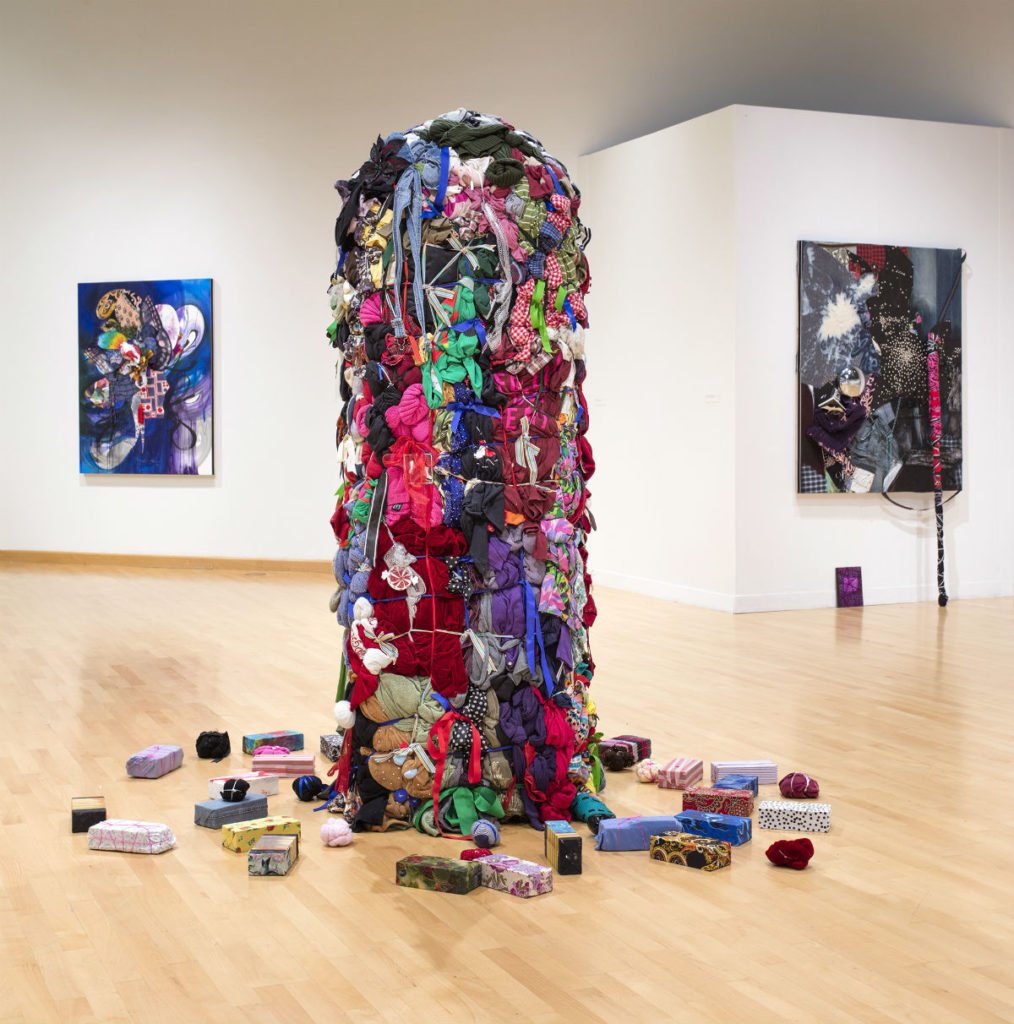
Shinique Smith, Bale Variant No. 0021 (Christmas) (2011-18). Photo by Brian Forrest and courtesy the artist and David Castillo Gallery.
I spent the majority of my time in “Refuge” with a tall, totemic Christmas bale, Bale Variant No. 0021 (Christmas) (2011-18), once I identified a black Santa mixed in among sweaters and other toys that were bundled together with gift tags and tied with grosgrain ribbon. The Santa was next to a blonde rag doll. When I mentioned the juxtaposition to Smith, she explained that for her, the placement symbolized an “equalizing” gesture. This, too, is something her second-hand materials allow her to evoke: a collection of people that may be different but share something in common.
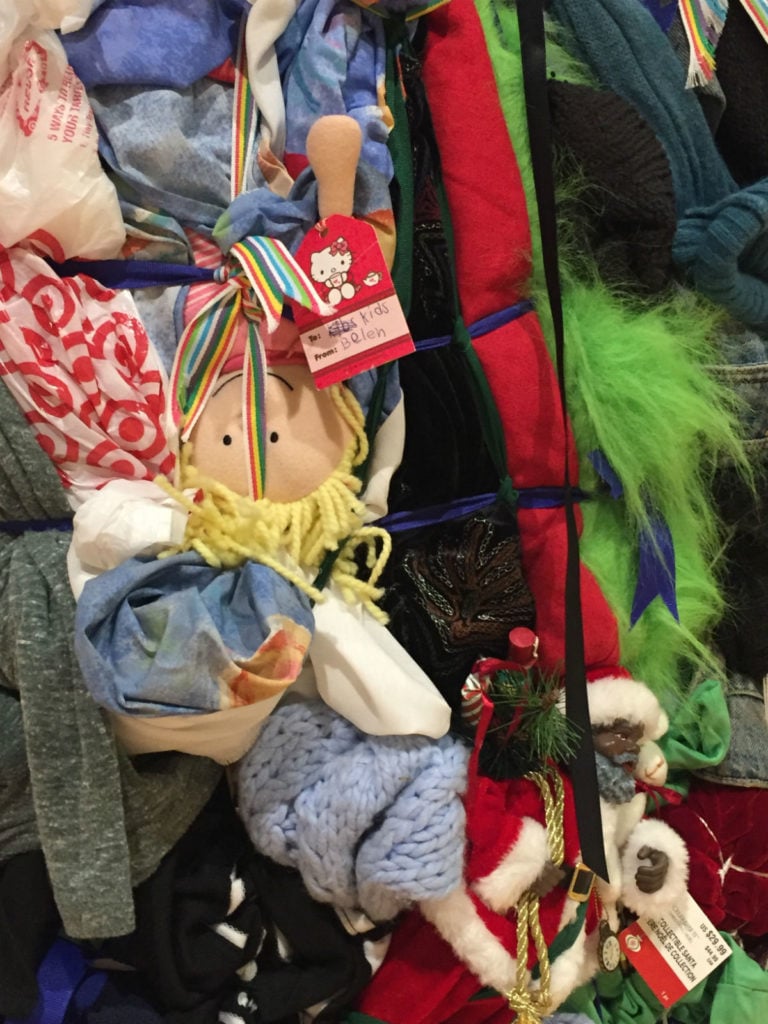
Detail of Shinique Smith, Bale Variant No. 0021 (Christmas) (2011-18). Photo courtesy Colony Little.
Throughout “Refuge,” Smith’s use of familiar materials establishes a visual bridge that connects her audience to the idea of shelter as a fundamental requirement for physical survival. The artist recently moved to Los Angeles from New York (where she still maintains a studio), and she remarked that the feeling of being caught in limbo between spaces informed many of the works in this CAAM show. Through this lens we see that there are different forms of displacement, a perspective that expands our capacity for empathy.
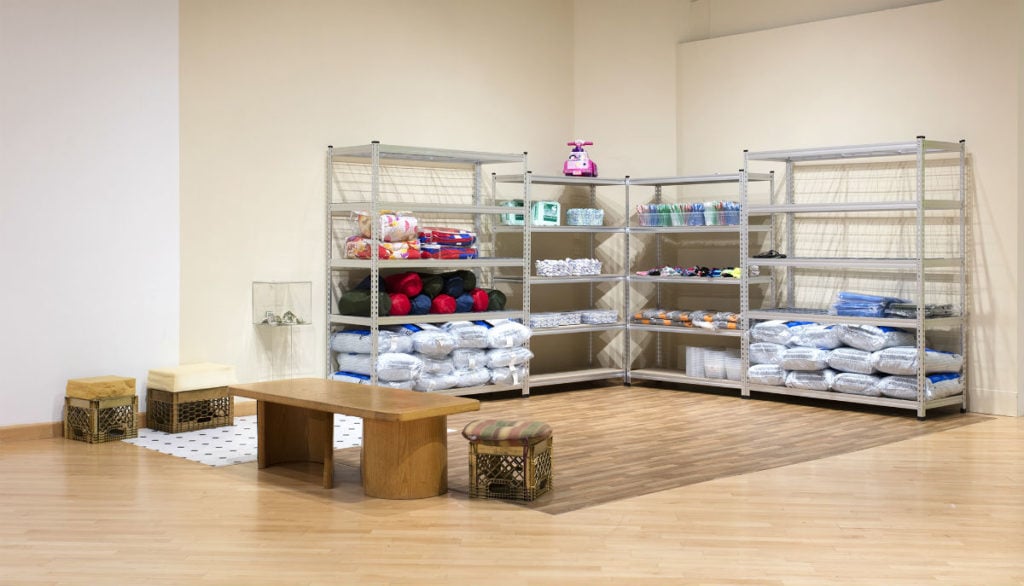
Shinique Smith, Donation Center (2018) in “Refuge.” Photos by Brian Forrest and courtesy the artist and David Castillo Gallery.
Yet a particularly extreme form of displacement confronts us in the city of Los Angeles, and Smith does not shy away from it. In the final installation of “Refuge” at the museum, she has created a work that doubles as a display for donations from the public of toiletries and other essentials, to aid the homeless. Within the gallery space, a series of shelves present travel sized soaps, toothpaste, deodorant, and feminine products, all displayed as they are collected, and intended for distribution at the conclusion of the show. With this gesture, Smith ties together the disparate threads of her artistic practice, going from reflecting on what the second-hand meant in the past, to what it could mean, in very human terms, in the future.
“Shinique Smith: Refuge” is on view at the California African American Museum through September 9, 2018.
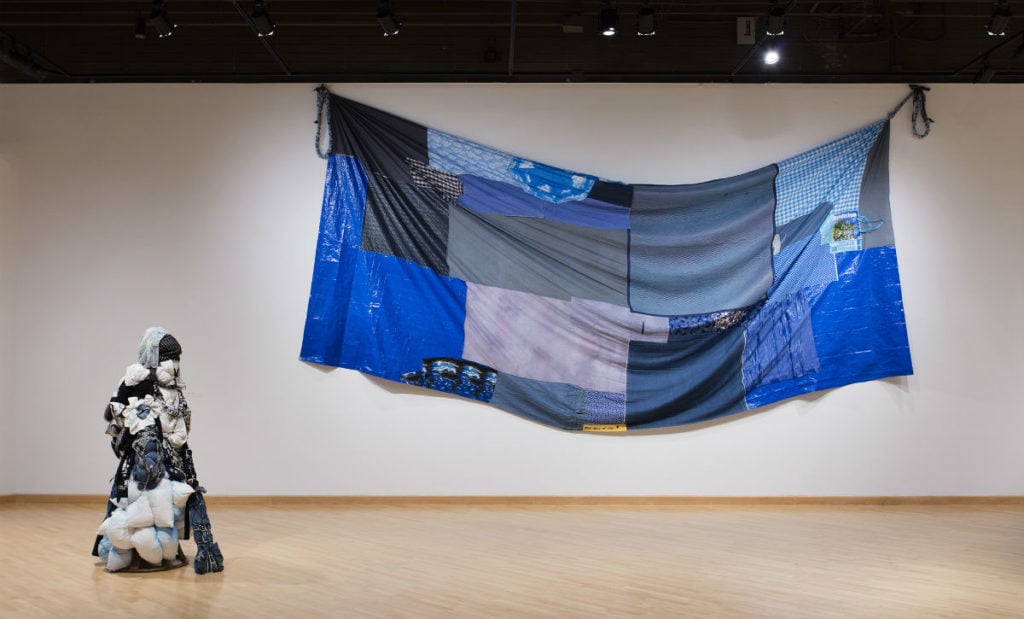
Shinique Smith, Sky Cloth (2018) at the California African American Museum. Photos by Brian Forrest and courtesy the artist and David Castillo Gallery.
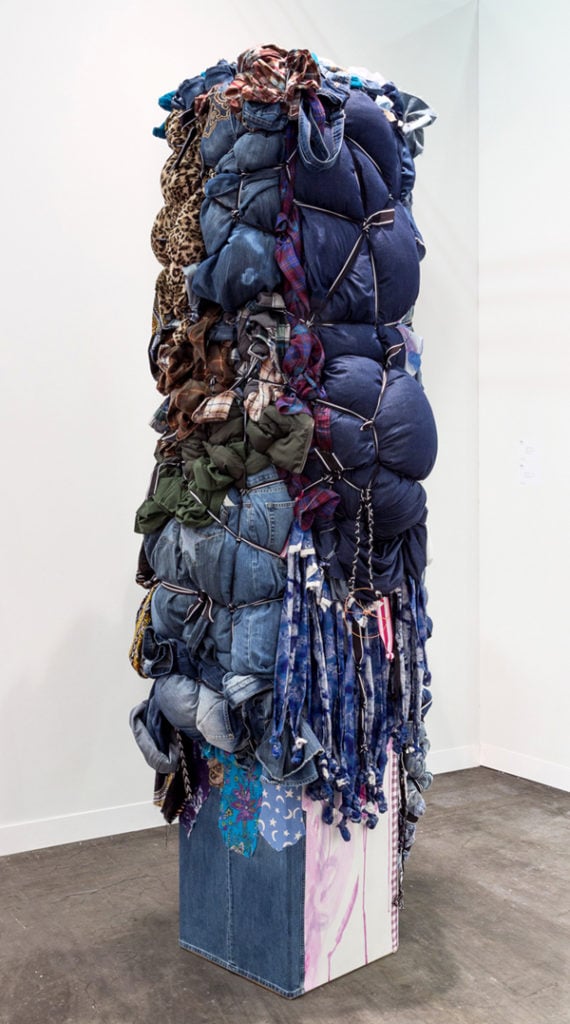
Shinique Smith, Bale Variant No. 0024 (Everything) (2017). Courtesy of the artist and David Castillo Gallery.
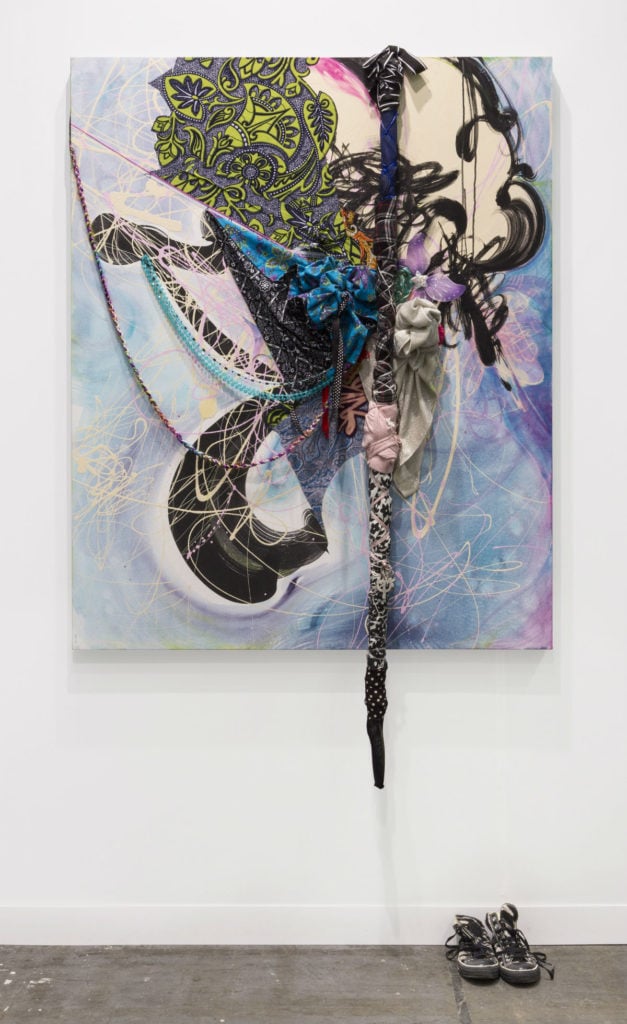
Shinique Smith, Beneath the Blue Veil (2016). Courtesy of the artist and David Castillo Gallery.
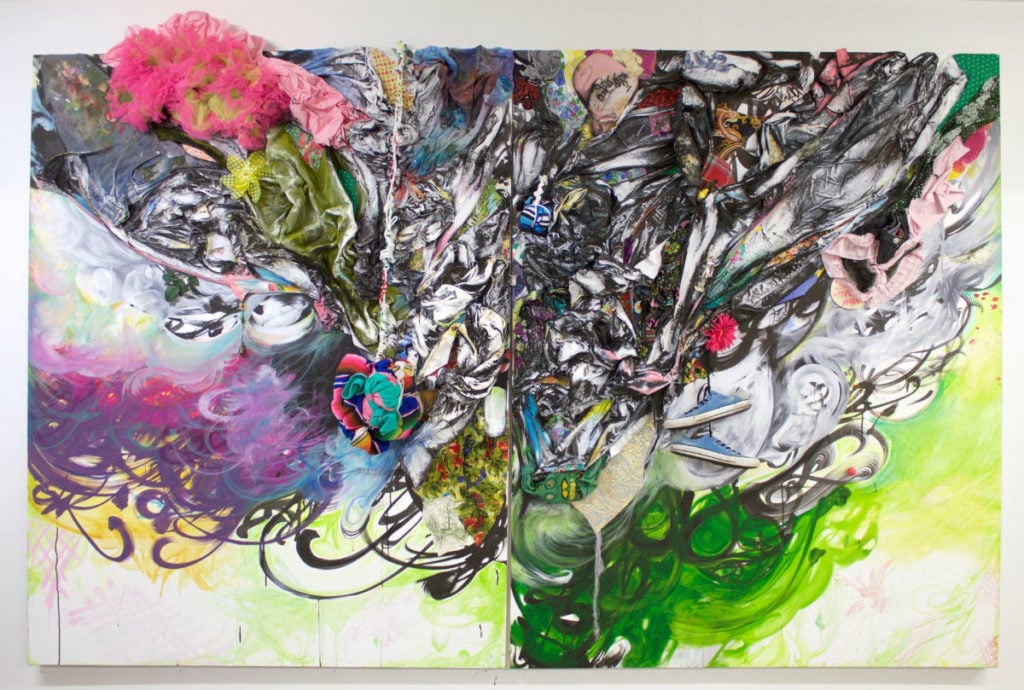
Shinique Smith, Shaped by Light, Shaped by Rainbows (2017). Courtesy of the artist and David Castillo Gallery.
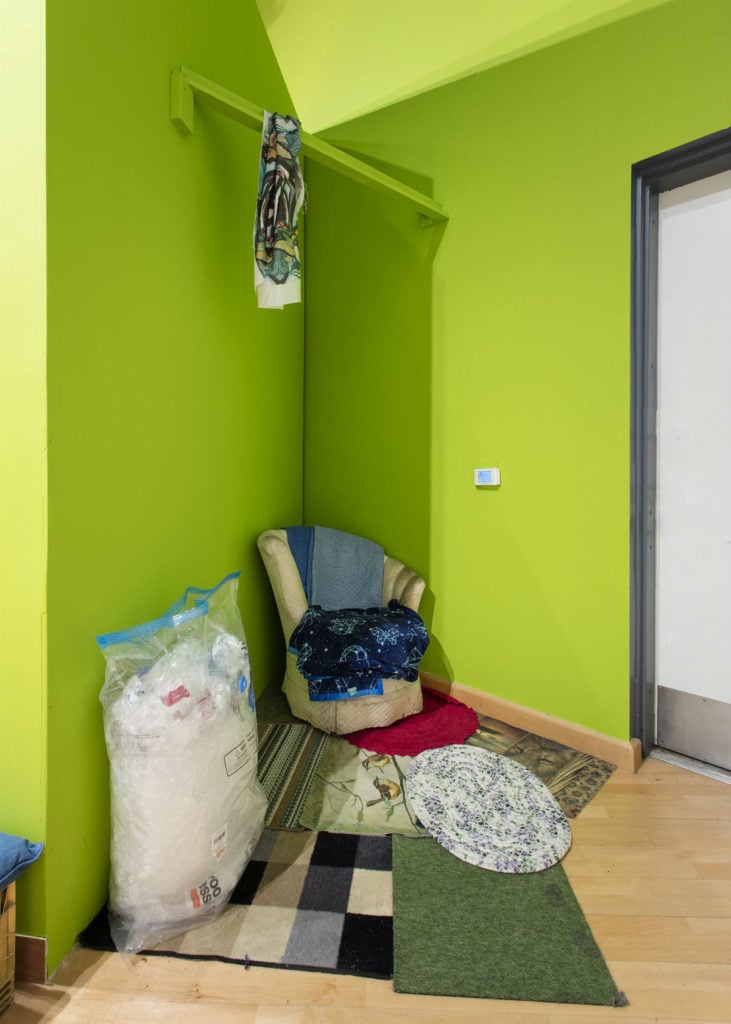
Installation view of “Shinique Smith: Refuge” at the California African American Museum. Photos by Brian Forrest and courtesy the artist and David Castillo Gallery.
![Shinique Smith, Donation Center [detail] in "Refuge." Image courtesy Colony Little.](https://news.artnet.com/app/news-upload/2018/04/shinique-smith-donation-detail-1024x768.jpg)
Shinique Smith, Donation Center [detail] in “Refuge.” Image courtesy Colony Little.
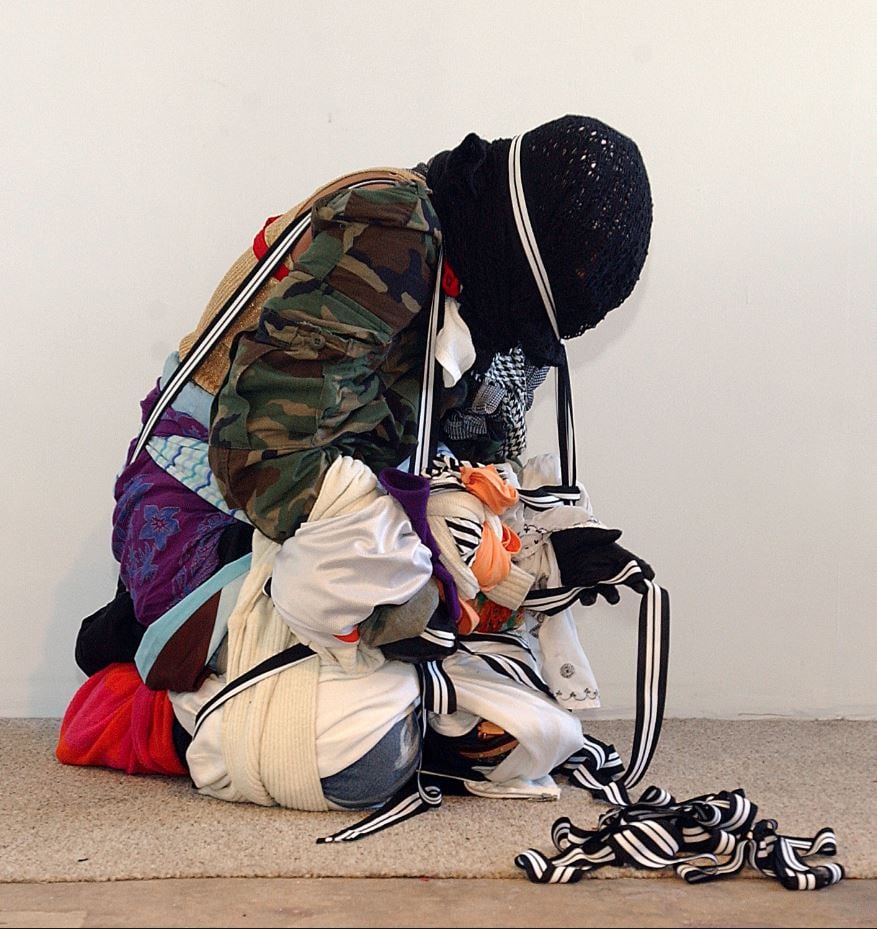




![Shinique Smith, <em>Donation Center</em> [detail] in "Refuge." Image courtesy Colony Little.](https://news.artnet.com/app/news-upload/2018/04/shinique-smith-caam-box-732x1024.jpg)








![Shinique Smith, Donation Center [detail] in "Refuge." Image courtesy Colony Little.](https://news.artnet.com/app/news-upload/2018/04/shinique-smith-donation-detail-1024x768.jpg)




